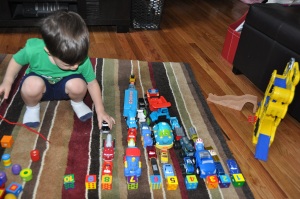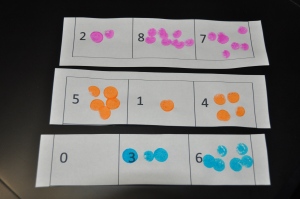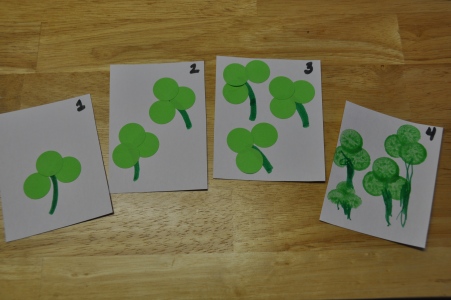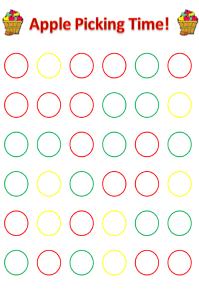When I was writing the Apple Picking post, I realized I never actually introduced our magnetic pompoms. This has been a great homemade toy for J. I saw it multiple places online when J was much younger and just waited until I was confident he would be safe with the small magnets. We’ve never had one fall off, but you never know. I wouldn’t leave little ones alone with this toy until you were 100% confident they wouldn’t try a taste test.
This is a great addition to a busy box gift for older toddlers/preschoolers. Include the pompoms, a small cookie sheet (found at dollar stores) and some blank templates and/or patterns to follow. A great and unique toy on a budget. It would even be a good homemade Christmas gift.
To Make: All you do is hot glue magnets onto the back of pompom balls. Use the free magnets you get in the mail to save money or buy roll of magnets from the craft store. You won’t need an entire roll, so it can be used for other things as well. Be sure to include a variety of color pompoms and a large number of each color. The more you have, the more your little one can create. You can also use multiple sizes of pompoms if you want (I’ve only made one size). Add a cookie sheet and you have a great toy. Something about pompoms intrigues kids.
1. They can design pictures freely.

No my toddler did not create this picture 🙂 This is one I made for him as he called out things to create. I forgot to snap pictures of his creations, though he makes a pretty good sun!
This homemade toy can be as simple as this and it will be worth the effort.
2. Black and white templates can be printed for them to fill in creatively.
I made this blank pompom template for J to use. You can also check out the links at the bottom of this post for sites I’ve found with printables.
3. Color printouts encourage them to match the correct colors.

Here he is matching the pompoms to the corresponding colored circle in the gumball machine. This type of activity is especially good for younger toddlers that are still working on their colors and fine motor skills.
It’s really easy to create your own, just copy and paste from Google images and add some colorful circles.
4. Patterns, sorting, counting, and colors
 I started the patterns and he found the right pompoms to continue it. You could also show them a picture of a pattern and ask them to copy it on their own. Preschoolers could work on much more intricate patterns or designs.
I started the patterns and he found the right pompoms to continue it. You could also show them a picture of a pattern and ask them to copy it on their own. Preschoolers could work on much more intricate patterns or designs.

This shows some color sorting as well as our intro to bar graphs where he compared the different bars to decide which had the most/the least, which were equal,… We finished by counting each bar to see we were right.
6. Shapes, Location
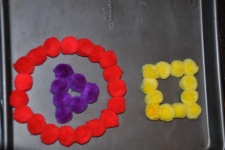 As of now we create them together, he copies my examples (or tries to), or he gives me instructions on what to create and where (good directional practice for them).
As of now we create them together, he copies my examples (or tries to), or he gives me instructions on what to create and where (good directional practice for them).
For older ones you can give them instructions to create a certain color/size shape, include location of the shape to increase the difficulty (ex: make a purple triangle inside the circle).
6. Letters and Numbers
Have your little one trace letters and numbers or “write” them on their own using the pompoms. You can draw large block letters or numbers for them to fill in with the pompoms. They can match the correct number of pompoms next to the correct number. Or check out the list of online templates I found.
I’ve seen activity books for Dot Markers that would work well with magnetic pompoms. Of course any of the templates for magnetic pompoms could also be used with Dot Markers or circles stickers too.
Other Printable Templates:
Shapes and Colors (from Home Grown Hearts)
Number cards (from 1+1+1=1)
Numbers (from Making Learning Fun)
Upper Case Letters and Lower Case letters (from Making Learning Fun)
B&W Pictures (From Making Learning Fun)
Color Pictures (From Making Learning Fun)
(For the Making Learning Fun templates, I had to copy the templates and paste it onto ppt to expand each picture. When I printed these straight from the website, the circles were much smaller than I wanted.)
If you find any other great templates let me know and I’ll add them to the list!
 This summer, J really got into tracing his footprints onto the sidewalk. We would trace all sorts of fun paths that he would then follow while running, jumping, skipping (or giving it his best attempt!), pushing his lawn mower or riding his tricycle.
This summer, J really got into tracing his footprints onto the sidewalk. We would trace all sorts of fun paths that he would then follow while running, jumping, skipping (or giving it his best attempt!), pushing his lawn mower or riding his tricycle.



 I’m always trying to think of different uses of the same old toys.
I’m always trying to think of different uses of the same old toys. 